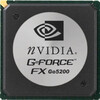NVIDIA GeForce FX Go 5700 vs NVIDIA GeForce FX Go 5600 / 5650 vs NVIDIA GeForce FX Go 5200
NVIDIA GeForce FX Go 5700
► remove from comparison
The NVIDIA GeForce FX Go 5700 is the strongest video card of the GeForce FX Go series. The direct competitor was the ATI Mobility Radeon 9600 / 9700, which was clearly faster in demanding games. It offers Multi-Display-Support (external screen additionally).
NVIDIA GeForce FX Go 5600 / 5650
► remove from comparison
The NVIDIA GeForce FX Go 5600 / 5650 for notebooks was established as a competitor to ATI Mobility Radeon 9600. However, the ATI card was clearly faster. It offers multi-screen-support (external screen additionally) and DirectX 9 functions. The successor was the enhanced GeForce FX Go 5700.
The 5600 has either 4x1 or 2x2 design (pixel- x vertex-shader), which depends on simple or double textured pixels.
NVIDIA GeForce FX Go 5200
► remove from comparison
The NVIDIA GeForce FX Go 5200 for laptops has been positioned as a competitor to ATI Mobility Radeon 9200. It offers multi-screen-support (additional external screen) and DirectX 9 functions.
Currently, it is a competitor of the faster integrated graphic chips like the ATI Radeon Xpress 1150.
The GeForce FX Go 5300 was an OEM version for Medion with lower clock (275/250 MHz) and 64 MB RAM.
| NVIDIA GeForce FX Go 5700 | NVIDIA GeForce FX Go 5600 / 5650 | NVIDIA GeForce FX Go 5200 | ||||||||||||||||||||||||||||
| GeForce FX Go Series |
|
|
| |||||||||||||||||||||||||||
| Codename | NV36M | NV31M | NV31M | |||||||||||||||||||||||||||
| Pipelines | 4 / 0 Pixel- / Vertexshader | 4 / 1 Pixel- / Vertexshader | 4 / 1 Pixel- / Vertexshader | |||||||||||||||||||||||||||
| Core Speed | 450 MHz | 350 MHz | 300 MHz | |||||||||||||||||||||||||||
| Memory Speed | 275 MHz | 300 MHz | 300 MHz | |||||||||||||||||||||||||||
| Memory Bus Width | 128 Bit | 128 Bit | 128 Bit | |||||||||||||||||||||||||||
| Memory Type | DDR | DDR | DDR | |||||||||||||||||||||||||||
| Max. Amount of Memory | 32 MB | 32 MB | 32 MB | |||||||||||||||||||||||||||
| Shared Memory | no | no | no | |||||||||||||||||||||||||||
| API | DirectX 9, Shader 2.0+ | DirectX 9, Shader 2.0+ | DirectX 9, Shader 2.0+ | |||||||||||||||||||||||||||
| technology | 130 nm | 130 nm | 150 nm | |||||||||||||||||||||||||||
| Features | PowerMizer 4.0, VPE 3.0, 128-Bit Color, nView Multi-Display, UltraShadow, Intellisample HCT, CineFX Engine 2.0 | PowerMizer, VPE, nView Multi-Display, Intellisample, CineFX Engine | 150nm, 1.2 - 1.3 Volt core tension, 4x FSAA, 8x AF, PowerMizer 3.0, maximally QXGA 2048x1536, no IntelliSample | |||||||||||||||||||||||||||
| Notebook Size | medium sized | medium sized | medium sized | |||||||||||||||||||||||||||
| Date of Announcement | 01.01.2004 | 01.03.2003 | 01.03.2003 | |||||||||||||||||||||||||||
| Information | 130nm, AGP | 150 / 130nm, AGP 8x, 6 Pixelshader-Operationen pro Clock-Signal | ||||||||||||||||||||||||||||
| Link to Manufacturer Page | www.nvidia.com | www.nvidia.com | www.nvidia.com |
Benchmarks
Average Benchmarks NVIDIA GeForce FX Go 5700 → 100% n=2
Average Benchmarks NVIDIA GeForce FX Go 5600 / 5650 → 77% n=2
Average Benchmarks NVIDIA GeForce FX Go 5200 → 51% n=2
* Smaller numbers mean a higher performance
1 This benchmark is not used for the average calculation
For more games that might be playable and a list of all games and graphics cards visit our Gaming List











